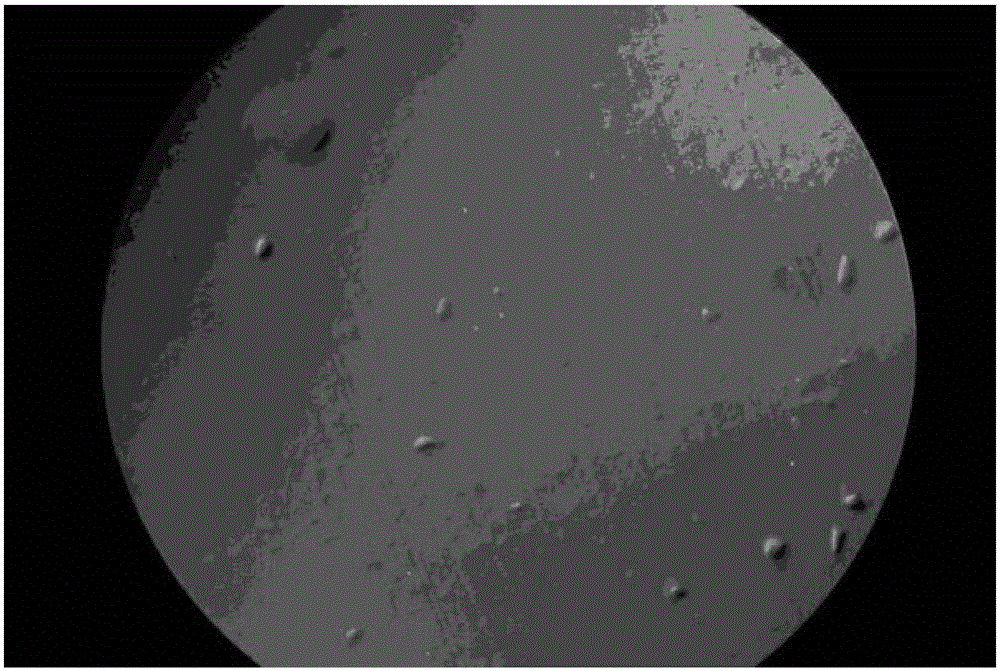Preparation method of p-layer silicon epitaxial wafer on p++ substrate
A technology of silicon epitaxial wafers and substrates, applied in semiconductor/solid-state device manufacturing, electrical components, circuits, etc., can solve problems such as drastic changes, increased leakage current, device failure, etc., to increase the uniformity of resistivity , increase control costs, and alleviate the effects of lattice changes
- Summary
- Abstract
- Description
- Claims
- Application Information
AI Technical Summary
Problems solved by technology
Method used
Image
Examples
Embodiment 1
[0041] (1) Use P+ / Boron single-sided polishing sheet, resistivity 0.004~0.0075Ω·cm, thickness 525±15μm, silicon wafer diameter 125±0.2mm, back LTO back seal, edge removal width ≤1mm;
[0042] (2) HCl in-situ polishing is performed at 1100°C, the HCl flow rate is 5slm / 10min, and the removal amount on the surface of the silicon wafer is 0.3 microns;
[0043] (3) Purge: use H 2 Purge the reaction chamber for 8 minutes, and discharge the impurities generated after the surface of the silicon wafer is polished out of the chamber, H 2 The flow rate is 140slm / 10min;
[0044] (4) Double-layer epitaxial growth: using high-purity SiHCl 3 Deposition and growth of resistivity graded layer, growth rate 0.40μm / min, growth temperature 1070°C, resistivity gradient layer thickness 1.4μm; then growth resistivity doped layer, growth temperature 1070°C, growth rate controlled at 0.8μm / min.
Embodiment 2
[0046] (1) Use P+ / Boron single-sided polishing sheet, resistivity 0.004~0.0075Ω·cm, thickness 525±15μm, silicon wafer diameter 125±0.2mm, back LTO back seal, edge removal width ≤1mm;
[0047] (2) HCl in-situ polishing is performed at 1130°C, the HCl flow rate is 5slm / 10min, and the removal amount on the surface of the silicon wafer is 0.4 microns;
[0048] (3) Purge: use H 2 Purge the reaction chamber for 10 minutes, and discharge the impurities generated after the surface of the silicon wafer is polished out of the chamber, H 2 The flow rate is 130slm / 10min;
[0049] (4) Double-layer epitaxial growth: using high-purity SiHCl3 Deposition and growth of the resistivity graded layer, the growth rate is 0.38μm / min, the growth temperature is 1080°C, the thickness of the resistivity gradient layer is 1.5μm; then the resistivity doped layer is grown, the growth temperature is 1100°C, and the growth rate is controlled at 1.0μm / min.
Embodiment 3
[0051] (1) Use P+ / Boron single-sided polished sheet, resistivity 0.004~0.0075Ω·cm, thickness 525±15μm, silicon wafer diameter 125±0.2mm, back LTO back seal, edge removal width ≤1mm;
[0052] (2) HCl in-situ polishing is performed at 1120°C, the HCl flow rate is 5slm / 10min, and the removal amount on the surface of the silicon wafer is 0.3 microns;
[0053] (3) Purge: use H 2 Purge the reaction chamber for 11 minutes, and discharge the impurities generated after the surface of the silicon wafer is polished out of the chamber, H 2 The flow rate is 170slm / 10min;
[0054] (4) Double-layer epitaxial growth: using high-purity SiHCl 3 Deposition and growth of the resistivity gradient layer, the growth rate is 0.42μm / min, the growth temperature is 1100°C, the thickness of the resistivity gradient layer is 1.3μm; then the resistivity doped layer is grown, the growth temperature is 1080°C, and the growth rate is controlled at 0.9μm / min.
PUM
| Property | Measurement | Unit |
|---|---|---|
| thickness | aaaaa | aaaaa |
Abstract
Description
Claims
Application Information
 Login to View More
Login to View More - R&D
- Intellectual Property
- Life Sciences
- Materials
- Tech Scout
- Unparalleled Data Quality
- Higher Quality Content
- 60% Fewer Hallucinations
Browse by: Latest US Patents, China's latest patents, Technical Efficacy Thesaurus, Application Domain, Technology Topic, Popular Technical Reports.
© 2025 PatSnap. All rights reserved.Legal|Privacy policy|Modern Slavery Act Transparency Statement|Sitemap|About US| Contact US: help@patsnap.com



